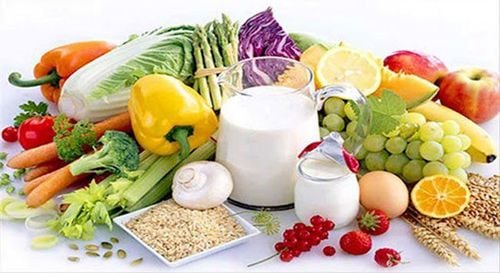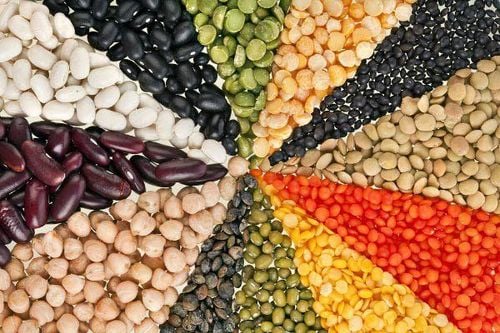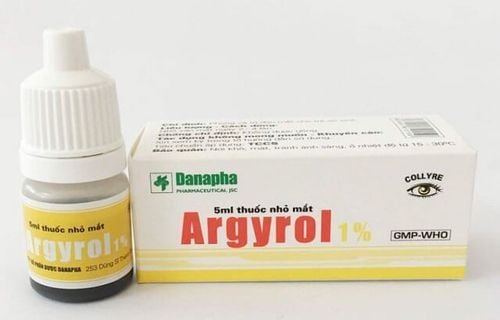This is an automatically translated article.
To adopt a sustainable and healthy lifestyle for your child, it is important to understand what a good source of nutrition consists of, and how it can affect a child's early childhood development and development. Steps you can take to make sure your child gets enough nutrients. This article helps to provide the necessary information about the impact of nutrition on the development of children.1. What is good nutrition for children?
Child nutrition is based on the same core principles as adult nutrition. The key is a healthy, balanced balance between diet and exercise. The five main food groups include grains, dairy, protein, vegetables, and fruits. The portion size of each respective food group will depend on the child's age, genetic makeup and physical activity. It is important to understand each food group to build a balanced and nutrient-dense diet for your child.1.1. Grains Grains can be divided into two categories: Whole grains and refined grains. Whole grains are more nutritious because they use the entire kernel. Whole grain products include oatmeal, whole wheat flour, and brown rice. Refined grains are grains that have been milled and processed multiple times to improve shelf life and texture. During the grain refining process, many valuable nutritional benefits are lost and therefore, whole grains are a better choice. Some examples of refined grains include tortillas, white bread, and white rice.
1.2. Vegetables Any vegetable or 100% vegetable juice is in the vegetable group. Vegetables can be raw, cooked, dehydrated, canned, whole, juiced or mashed and are divided into 5 subcategories including dark green vegetables, starchy vegetables, red and orange vegetables, beans - peas Orchid and other vegetables. The serving size of each will depend on the subcategory it belongs to as some vegetables are denser and contain more nutrients than others. Vegetables can also be classified into other subcategories including organic and non-organic.
1.3. Fruit Any fruit or 100% fruit juice is a fruit. Fruit can be canned, frozen, dried, pureed or pressed. Because of the high sugar content in fruit, it's important to develop a balanced diet based on your age, activity level, time of day, and gender. Like vegetables, fruit can be further classified into organic, non-organic and non-gmo.
1.4. Protein and dairy The protein food group is made up of foods that are primarily sources of protein such as meat, poultry, beans, peas, eggs, seafood, and nuts. Recommended sources of meat and poultry are lean and low-fat.
All liquid dairy products and products made primarily from milk are in the dairy food group. These include items like milk, yogurt, and cheese. In recent years, milk has been a controversial "member" of the food group and as a result, many milk alternatives have been offered with greater nutritional value. This group also contains fortified dairy alternatives such as soy, almond, cashew milk and nut cheese.
Based on your child's age and genetic makeup, their diet and lifestyle may vary. Pay attention to certain nutritional guidelines for a certain age.

Các loại hạt, rau củ, trái cây, protein và sữa là những thực phẩm cần có trong chế độ dinh dưỡng cho trẻ
2. Good nutrition for toddlers
Toddlers (1 - 3 years old) can be a particularly difficult age when it comes to eating a nutritious diet. During this time frame, many developmental changes have a direct effect on a child's food or supplement intake. Toddlers are in a phase of growth and development that is essentially slowing down, affecting feelings of hunger and dieting. In addition to reducing appetite, toddlers are at an age where they want to explore the world around them. This can lead to mothers choosing foods, meal times, and specific amounts for their babies.Depending on their age, activity level and gender specific, toddlers should eat about 3 - 5 ounces of whole grains per day. One ounce is equivalent to 1 piece of bread, 1/2 cup of rice or oatmeal, or one small (4-inch) pancake.
Regarding vegetables, toddlers should eat 1-2 cups of vegetables per day from each of the 5 types above. Cooked and tender vegetables should be given to children cut into very small pieces. Not only will this help your toddler chew and swallow vegetables, but it will also reduce the risk of choking.
Toddlers should also consume 1 cup of fruit per day. You can split into 1⁄2 bananas for breakfast, 1⁄2 apples for snack, 8 sliced grapes, 1⁄2 cups cooked broccoli, 12 cups peas and carrots . It's important to try a variety of the five food groups to get their full nutritional benefits. In general, most toddlers should get about 13 grams of protein per day.
A general rule that can be helpful when determining how much protein your child should get each day is based on their weight. The recommended dietary intake of protein, or RDA, is determined using the guideline: 0.5 grams of protein per pound of body weight. Therefore, a 2-year-old who weighs 30 pounds will need about 15 grams of protein per day. This amount of protein is equivalent to 1/2 egg, 1 tablespoon peanut butter or 1⁄4 cup beans. Calcium-fortified juices, milk, and cheeses should be consumed by toddlers in smaller amounts, such as 1 cup of milk or 2 ounces of cheese per day.
3. Good nutrition for preschoolers
The preschool years (ages 3 - 5) are an influential time in developing healthy habits for children that can last a lifetime. Preschoolers tend to grow quickly and as a result, their appetites may be intermittent. The recommended amounts of grains, protein, vegetables, fruit, and dairy for preschoolers are like toddlers and vary by size, age, and sex. An important component for growing preschoolers is calcium intake. Calcium is essential for the development of strong bones and teeth.Contrary to popular belief, calcium is not best absorbed through traditional milk. It's best to get calcium through dark green leafy vegetables like kale, broccoli, and collard greens. About 1/2 cup of cooked greens can provide about 300 mg of calcium with an absorption rate of 40%. Another important supplement to focus on is fiber. Fiber aids digestion and prevents constipation by encouraging bowel movements. Fiber is found in most whole grain products as well as fruits and vegetables. While it can be challenging at times to convince your child to eat vegetables instead of starchy processed foods like macaroni, cheese and chicken nuggets, it's worth trying because it's great for your health. child's health.

Khi chăm sóc trẻ, bạn cần lưu ý cung cấp dinh dưỡng phù hợp với độ tuổi
4. How can nutrition affect young children?
A nutritious diet and healthy lifestyle can affect young children for the rest of their lives. During the early stages of development, children are very impressed and begin to practice habits taught by their parents that they will continue to practice as adults.Children who do not receive proper nutrients as they grow can suffer from physical diseases. Some of the most common problems for malnourished children include obesity, osteoporosis, decreased muscle mass, changes in hair quantity and texture, fatigue, irritability, and type 2 diabetes. Obesity is a growing epidemic affecting children at an alarming rate in the United States. Obesity is associated with having excess body fat in the 95th percentile of their respective BMI, i.e. Body Mass Index.
Children who do not have a balanced diet and consume a lot of fat, sugar and processed carbohydrates are at risk of obesity. Obesity can lead to a number of health problems that can affect children for the rest of their lives including high blood pressure, type 2 diabetes, high cholesterol, and emotional problems. Young children are very susceptible to self-pity and shame about their appearance as well as emotional problems related to the food they consume. When children consume sugary, processed and high-fat foods, it also affects their digestive system and gut microbiota.
Lack of calcium absorption can lead to osteoporosis. Osteoporosis is a degenerative bone disease that results in spongy, weak, and brittle bones. Nutrition and lifestyle choices that children and parents make early on can affect children for the rest of their lives. To be able to reach peak bone mass by age 20, it is important to build muscle and bone mass during early childhood.
Children who are overweight tend to be tired and irritable leading to depression. Children who are overweight have difficulty with physical activity and are often unable to participate in physical activities with their peers. This can cause emotional isolation and can set the stage for poor social interactions and low self-esteem. Overall, a healthy and balanced nutritious diet is paramount to a child's development.

Chế độ dinh dưỡng phù hợp có thể giúp trẻ phát triển khỏe mạnh và toàn diện
5. How to make sure your child eats right and stays healthy?
Theory and practice in guiding your child to develop a healthy and balanced nutritional life are two completely different things. It can be difficult to make sure your child is eating right and staying healthy without regular support, guidance, education, and support. As young children develop, they begin to form opinions about what works for them and what doesn't. Most of what children want to eat is not suitable for a healthy diet. That's what makes it difficult for parents.Stanford Children's Health recommends avoiding conflicts over parents' and children's food choices. Children can be picky and sometimes, they refuse to accept certain foods. If your toddler or preschooler doesn't want to eat certain foods, it's best to skip it and try again another time. If you force them to eat, they will most likely get angry and this is not good for their health. As mentioned, young children are developing their independence and opinions, so we should respect and teach them slowly. You can try eating with your child, taking them to certain places to eat and talking more with them. When you create eating habits and mealtime interactions with your child, they can form positive associations and are more receptive to your opinions on what foods they should or shouldn't eat.
Involving children in food preparation and selection can also be an important form of education. You can let your child choose from the grocery store or your own refrigerator. It helps to make food choices with your child based on their nutritional value and explain to your child how they can help their body grow. Over time, this will help your child develop healthy food habits as they grow.
Today, many parents are so busy with work that they forget that preparing food for their children to bring to school is extremely important and should be done. This will help ensure your child has a healthy, balanced, and healthy meal. In addition, physical activity is equally important. Children are recommended to get at least 60 minutes of moderate to vigorous physical activity most days of the week.
Parents should limit the use of television and video games to give their children more physical activity habits such as walking, running and playing ball. The key is for parents to be actively involved in their children's lives in addition to nutrition and exercise because children primarily learn through direct observation. By being an example, you're showing your kids a positive, healthy, and sustainable lifestyle so they can create habits for themselves.
For children to be healthy and develop well, it is necessary to have a nutritious diet in terms of quantity and quality balance. If children are not provided with adequate and balanced nutrients, it will lead to diseases of excess or lack of nutrients, which adversely affect the comprehensive development of children in terms of physical, mental and motor skills.
Children who do not eat properly are at risk of micro-mineral deficiency causing anorexia, growth retardation, malabsorption,... If they notice the above signs, parents should supplement their children with products. The supplement contains lysine, essential micro-minerals and vitamins such as zinc, chromium, selenium, and B vitamins to help fully meet the nutritional needs of children. At the same time, these essential vitamins also support digestion, enhance nutrient absorption, help improve anorexia, and help children eat well.
Parents can learn more:
Signs of zinc deficiency in children
Micronutrient deficiency and failure to gain weight in children
Please regularly visit Vinmec.com website and update useful information to take care of your child. Take care of the baby and the whole family.
Reference article: unicef.org













